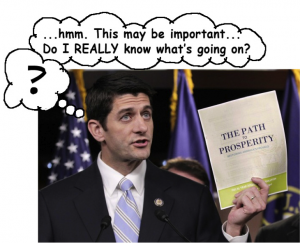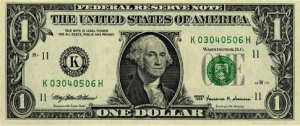By J.D. ALT
I keep trying to unravel the confusion knotted beneath the surface of our public discourse about money.
For example, it seems evident that most people believe that U.S. Dollars are “created” by business entrepreneurs making profits. Until this happens, the understanding seems to be, the number of dollars available for everyone to try to get some share of is like a big lake of money we’re all drinking from, with the biggest drinker of all being the U.S. government. What we seem to mean by “economic growth” is this lake growing bigger, and we’re constantly measuring it’s depth and volume in terms of something we call “Gross Domestic Product”. The process that makes the money-lake grow is an entrepreneur investing some of the existing dollars in some venture, and then making a profit on that investment thereby creating new dollars that didn’t exist before, which increases the overall size of the lake. Dollars created in this way are “real” dollars because they are created by private business entrepreneurs competing in a free market. The federal government (for some mysterious and perverse reason that we can’t entirely explain) has the authority to “print” dollars any time it sees the need, but dollars created in this fashion are “funny money”—they simply dilute the value of the “real” dollars and enable the federal government to spend money it doesn’t really have. To protect the “soundness” of our lake of money, we should therefore limit at all costs the federal government’s “printing” of dollars, and the most effective way to achieve this goal is to require the federal government to BORROW dollars from the bond market if, in fact, it has to spend more dollars than it collects in taxes. Having imposed this requirement, we must then carefully track the number of dollars the federal government borrows because if that number exceeds a certain percentage of our Gross Domestic Product, we can assume the government will never be able to repay the debt (because the taxes available from GDP are mathematically inadequate) at which point the federal government will be insolvent. When we reach the point that the federal government is borrowing too many dollars (and, therefore, approaching insolvency) we have to either raise taxes or reduce government spending. If we raise taxes—especially on the entrepreneurs and businessmen—that will reduce the incentive to invest and create jobs, and will slow the process by which new “real” money is created, causing economic growth to falter. The best course of action to reduce an overly large federal debt, therefore, is to reduce federal spending. On its surface, this seems a perfectly reasonable narrative, even though it is politically difficult to translate into action (as we are currently observing.)
Continue reading →
 There’s a joke about a farmer and his pig. The pig is covered with a patchwork of large and small Band-Aids. A puzzled visitor asks the farmer: “Why is your pig covered all over with Band-Aids?” “Well,” says the farmer, “obviously, I can’t butcher him all at once: if I cut out too much he might die—and then I’d soon have nothing to eat.”
There’s a joke about a farmer and his pig. The pig is covered with a patchwork of large and small Band-Aids. A puzzled visitor asks the farmer: “Why is your pig covered all over with Band-Aids?” “Well,” says the farmer, “obviously, I can’t butcher him all at once: if I cut out too much he might die—and then I’d soon have nothing to eat.”




 One of the strangest things to understand about Modern Money Theory is why, if government doesn’t need your tax dollars in order to spend, does government tax at all? Here is an attempt at a new and “better” explanation. It is based on the insight that the government DOES, in fact, need to collect taxes, but the “taxes” it collects are not your “tax dollars.” This may sound like gibberish, but stick with me a moment and see if the following doesn’t make sense—and cast a new light on OTHER things as well (like, for example, the “national debt”).
One of the strangest things to understand about Modern Money Theory is why, if government doesn’t need your tax dollars in order to spend, does government tax at all? Here is an attempt at a new and “better” explanation. It is based on the insight that the government DOES, in fact, need to collect taxes, but the “taxes” it collects are not your “tax dollars.” This may sound like gibberish, but stick with me a moment and see if the following doesn’t make sense—and cast a new light on OTHER things as well (like, for example, the “national debt”). In a recent
In a recent 








